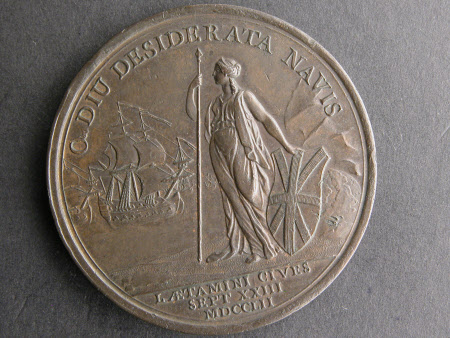The visit of Prince Charles to London
attributed to Thomas Pingo the elder (1692-1776)
Category
Coins and medals
Date
1752
Materials
Silver
Measurements
43 mm (Diameter)
Place of origin
Great Britain
Order this imageCollection
Osterley Park and House, London
NT 773310
Summary
Silver, medal commemorating the visit of Prince Charles Edward Stuart, The Young Pretender (1720-1788) to London, attributed to Thomas Pingo (1692-1776), struck Great Britain, 1752. A silver medal attributed to Thomas Pingo commemorating the visit of Prince Charles Edward Stuart, the Young Pretender to London in 1752. On the obverse, the Prince in profile facing right. Latin legend translates as: ‘May he, the great genius of Britain, return.’ On reverse, Britannia, with her spear and shield, stands on a rocky shore, a globe with map of Britain behind her. She awaits the arrival of a fleet. Legend translates as: ‘Oh, long-hoped for ship’ and, in the exergue, ‘Let us rejoice, citizens, 23 September 1752’
Full description
A Jacobite medal made for distribution among the supporters of the claim to the British throne of Charles Edward Stuart, the Young Pretender, who had been in exile in France since the failure of the 1745 Uprising. In 1752 another insurrection was being planned and Prince Charles is said to have made a secret visit to London, where he lived incognito for some weeks, staying in the house of Lady Primrose. Realising that the new plot had no chance of success, he returned to Paris. The medal consciously reprises a medal that is dated 1745, so appears optimistically to herald the Young Pretender’s attempted invasion in the summer of that year, but was in fact struck three years later at the time of the Treaty of Aix-la-Chapelle in 1748, which brought the War of the Austrian Succession to an end (NT 773305-773306). One of the clauses of the Treaty dealt a blow to the Jacobite clause since the French recognised the legitimacy of the Hanoverian government in Britain. The 1752 medal uses on the obverse the same portrait of the Young Pretender, after a portrait bust by the French sculptor Jean-Baptiste Lemoyne (1704-1778; see an example at Sizergh Castle, NT 998576; see also the Oak Medal made by Thomas Pingo for a Jacobite society in London in 1750, example at Osterley NT 773309). The design of the reverse is also essentially the same as that for the “1745” medal, but the optimistic legend is different. Jeremy Warren 2019
Provenance
Given to the National Trust in 1993 by George Child Villiers, 9th Earl of Jersey (1910-1998).
Marks and inscriptions
Obverse legend: REDEAT MAGNUS ILLE GENIUS BRITANNIÆ Reverse legend: O DIU DESIDERATA NAVIS Reverse exergue: LÆTAMINI CIVES SEPT XXIII MDCCLII
Makers and roles
attributed to Thomas Pingo the elder (1692-1776), medallist
References
Cochran-Patrick 1884: Robert William Cochran-Patrick, Medals of Scotland from the earliest period to the present time, Edinburgh 1884, p. 74, no. 61, Pl. XIV.5 Hawkins, E. (ed.) Franks, A.W. and Grueber, H.A: Medallic Illustrations of the History of Great Britain and Ireland to the death of George II, 2 vols,. London, 1885, II, p. 670, no. 380 Woolf 1988: Noel Woolf, The Medallic Record of the Jacobite Movement, London 1988, pp. 121-22, no. 65:1. Eimer 2010: Christopher Eimer, British Commemorative Medals and their Values, London 2010, p. 102, no. 639, Pl. 72

